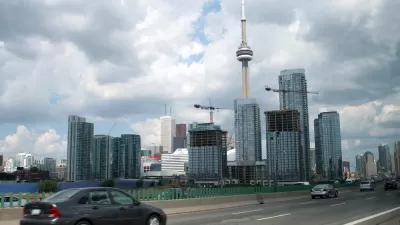As it rebuilds the Gardiner Expressway, Toronto could use the opportunity to create more real estate for affordable housing.

As it finalizes its 2021 budget, the city of Toronto will award the contracts to finish the Gardiner Expressway reconstruction project, with options to rebuild an elevated expressway or get more creative with the use of land in Toronto's dense downtown. In a piece for the Globe and Mail, Alex Bozikovic argues that combining the eastern end of the expressway with Lake Shore Boulevard "would open up more than five acres of land for a new neighbourhood, which could generate $500-million in land sales and development charges," generating "enough to build hundreds of units of affordable housing."
Despite the benefits promised by the "boulevard" plan, which would merge the expressway with Lake Shore Boulevard for a short segment and cost significantly less, the city council opted for a "hybrid" option that opens up far less land for new development. "That extra acreage is now worth roughly $450-million, according to Jeremiah Shamess, a vice-president at Colliers Canada who specializes in development land." The speculative proposal used for this analysis "imagines 6.5 million square feet of buildings in this area, with 8,000 homes housing 15,000 people and a mix of other uses."
With 200,000 more people expected to move into downtown Toronto in the next two decades, Bozikovic argues that Gardiner East, with its density and proximity to transit, is "a fine place to plan a postpandemic urban neighbourhood."
FULL STORY: The East Gardiner: a stretch of highway, or a new neighbourhood?

Study: Maui’s Plan to Convert Vacation Rentals to Long-Term Housing Could Cause Nearly $1 Billion Economic Loss
The plan would reduce visitor accommodation by 25% resulting in 1,900 jobs lost.

Alabama: Trump Terminates Settlements for Black Communities Harmed By Raw Sewage
Trump deemed the landmark civil rights agreement “illegal DEI and environmental justice policy.”

Why Should We Subsidize Public Transportation?
Many public transit agencies face financial stress due to rising costs, declining fare revenue, and declining subsidies. Transit advocates must provide a strong business case for increasing public transit funding.

Paris Bike Boom Leads to Steep Drop in Air Pollution
The French city’s air quality has improved dramatically in the past 20 years, coinciding with a growth in cycling.

Why Housing Costs More to Build in California Than in Texas
Hard costs like labor and materials combined with ‘soft’ costs such as permitting make building in the San Francisco Bay Area almost three times as costly as in Texas cities.

San Diego County Sees a Rise in Urban Coyotes
San Diego County experiences a rise in urban coyotes, as sightings become prevalent throughout its urban neighbourhoods and surrounding areas.
Urban Design for Planners 1: Software Tools
This six-course series explores essential urban design concepts using open source software and equips planners with the tools they need to participate fully in the urban design process.
Planning for Universal Design
Learn the tools for implementing Universal Design in planning regulations.
Smith Gee Studio
Alamo Area Metropolitan Planning Organization
City of Santa Clarita
Institute for Housing and Urban Development Studies (IHS)
City of Grandview
Harvard GSD Executive Education
Toledo-Lucas County Plan Commissions
Salt Lake City
NYU Wagner Graduate School of Public Service




























